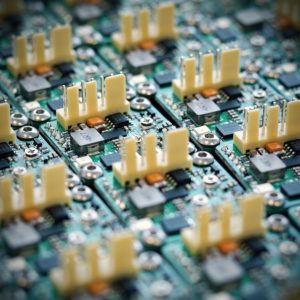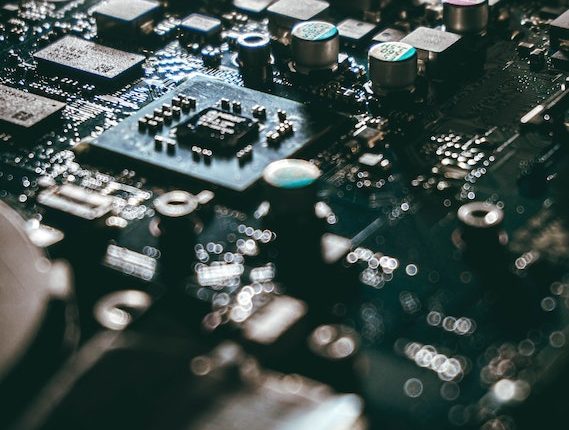Understanding Indium Phosphide and Its Properties
The binary semiconductor, Indium Phosphide (InP), boasts of singular optical and electronic properties. This particularity renders it an indispensable actor in the optoelectronics sphere. It’s noteworthy how its elevated electron velocity permits devices to operate at amplified frequencies – a seismic shift that has been instrumental in propelling telecommunication systems forward. Consequently, materials derived from InP are of paramount importance when fabricating a diverse range of optoelectronic devices encompassing lasers and photodetectors which find their utility in fiber-optic communication systems.

A striking use-case for Indium phosphide is its deployment within the territory of heterojunction bipolar transistors (HBTs). These specialized transistors harness InP due to its superior electron mobility coupled with thermal stability surpassing other semiconducting materials available on the market. The manufacturing process incorporates layering dissimilar types of InP onto a wafer base with an aim to yield a transistor showcasing enhanced performance metrics such as speed and efficiency. Importantly, employing indium phosphide ensures HBTs maintain functionality even under severe temperature conditions.
Yet another pivotal domain where Indium Phosphide claims widespread application is during crafting photonic integrated circuits (PICs). These innovative circuits amalgamate numerous photonic functions into one compact chip hence minimizing size while simultaneously boosting functionality. Fabrication involves complex procedures comprising lithography and etching techniques carried out on an InP wafer substrate. The ensuing PICs have brought about revolutionary changes particularly within industries like telecommunications by facilitating high-speed data transmission over extended distances devoid any signal loss or degradation.
The Role of Indium Phosphide in Optoelectronic Devices
In the dynamic domain of optoelectronic apparatuses, Indium Phosphide (InP) holds a position of quintessential importance thanks to its extraordinary characteristics. This particular semiconductor material is celebrated for its exceptional electron mobility and direct bandgap – attributes that make it an impeccable substrate choice for photonic integrated circuits. The crafting process entails layering InP on a wafer, subsequently followed by intricate etching procedures to manifest elaborate circuit designs.

The incorporation of InP in optical interconnects has led to a significant amplification in data transmission velocities while simultaneously diminishing energy utilization. Its inherent capacity to radiate light when subjected to an electrical bias renders it irreplaceable in laser technology, extensively leveraged within telecommunication systems. Furthermore, the superior velocity at which electrons travel through InP enables devices fabricated from this material to function at elevated frequencies relative to other semiconductors, bestowing upon them increased bandwidth and accelerated signal processing capabilities.
Delving deeper into the fabrication mechanism pertaining to Indium Phosphide reveals numerous superiority aspects over conventional methods. It allows for meticulous control over doping concentration and laminar thicknesses with nanometer-level precision – key determinants influencing device performance metrics significantly. Despite confronting hurdles such as cost-effectiveness barriers and complex manufacturing sequences tied up with this progressive material technology advancement, continual research efforts are being channeled towards refining production techniques aiming at enhanced yield rates along with improved quality standards relating specifically to InP-based optoelectronic devices.
Fabricating Optical Interconnects with InP-Based Materials
The intricate artistry involved in the construction of optical interconnects utilizing InP-based materials is a multi-tiered process, brimming with complexities. As we step into the labyrinth of creation, we are greeted first by an inp substrate – playing host to our future optoelectronic devices.
This base material whispers tales of its composition; it’s primarily indium phosphide (InP), a member of the III-V semiconductor family. Its crystal structure bears an uncanny resemblance to gallium arsenide (GaAs). However, they differ in their essence – unlike GaAs, InP boasts a larger band gap and greater electron velocity that make it favourable for high-speed applications.
Moreover, there lies one significant triumph for InP over silicon when fabricating these optoelectronic warriors: its direct bandgap property. This enables efficient light emission and absorption at wavelengths hovering around 1300 nm and 1550 nm – frequencies crucially employed within telecommunications’ ambit. To sculpt specific device structures like diodes or transistors on this substrate stage, epitaxial growth techniques come into play.
Epitaxy spins stories about layering – growing successive layers while preserving their lattice alignment relative to the foundational layer beneath them. This method grants precise command over dopant concentration levels and thicknesses down to nanometer scales – factors pivotal in devising photonic circuits or any other integrated circuitry genre.
Furthermore, it paves way for superior incorporation rates between indium and phosphorus atoms during growth compared with only silicon substrates; hence marching towards enhanced overall performance attributes intrinsic to these masterfully fabricated devices.
Exploring Heterojunction Bipolar Transistors and Their Fabrication Using InP
In the realm of transistors, Heterojunction Bipolar Transistors (HBTs) stand apart due to their unique construction. With distinct semiconductor materials employed for the emitter and base regions, a heterojunction is formed. The binary semiconductor known as Indium Phosphide (InP) has risen as an ideal component in crafting these devices owing to its remarkable characteristics.
When placed alongside alternatives such as gallium arsenide, InP reveals superior electron velocity—a trait that makes it indispensable in high-velocity and high-frequency applications like those seen in integrated circuits within communication systems.
The process through which these are constructed involves intricate procedures; thin layers of indium phosphide nanocrystalline are meticulously deposited on a substrate via Metalorganic Vapor Phase Epitaxy (MOVPE). This technique, put forth by Wang and Liu provides unparalleled control over layer thickness down to μm level while still maintaining uniformity across considerable expanses.
Utilizing white phosphorus and indium during this vapor phase epitaxy results in exceptionally pure layers with minimal defects—a key factor contributing towards significant performance enhancements for HBTs.
Following fabrication, each device undergoes thorough examination using techniques such as scanning electron microscopy. This ensures structural integrity and quality assessment at microscopic levels. Upon analysis, one notices that these transistors showcase exceptional operational stability extending up till several GHz frequencies.
Indeed, the advantageous properties of InP-based HBTs—high electron mobility and saturation velocity coupled with low noise figure at higher frequencies—make them ideally suited for advanced optoelectronic applications.
Unveiling the World of Transistors: The Role of Indium Phosphide
In the intricate world of transistors, a critical player has emerged in the form of Indium Phosphide (InP), thanks to its unique characteristics. InP is a prominent member of the III-V semiconductor family and is renowned for its extensive use in high-frequency electronics and telecommunications. The reason? It’s all about speed – electron velocity, to be precise. Compared with other materials, InP can boast superior electron velocity which translates into more efficient operation of electronic devices. This efficiency reduces energy consumption while simultaneously boosting performance.
But what sets InP apart is not just its speed but also its direct band gap property, an attribute that makes it perfect for optoelectronic applications such as laser diodes and photodetectors. With this direct band-gap feature at play, efficient light emission becomes possible giving rise to highly responsive devices boasting excellent optical characteristics based on InP.
The plot thickens when we introduce another character: Indium Gallium Arsenide (InGaAs). By doping InP with this fellow III-V semiconductor, one can further amplify these properties resulting in even higher efficiency and additional functionality within electronic components.
To truly comprehend how all these elements work together microscopically requires insightful tools like scanning electron microscopes. These powerful instruments provide a glimpse into the meticulous details involved in transistor fabrication using InP; from device creation processes like etching or deposition observed closely on a semiconductor wafer’s sidewall under the microscope lens ensuring precision during manufacturing which significantly contributes towards achieving peak performance from our transistors & related electronic systems.
An In-Depth Study into the Role of InP in Semiconductor Wafers
Indium Phosphide – a binary concoction of indium and phosphorus, is the latest sensation in the optoelectronics sphere. This cubic crystalline compound has been stirring interest due to its singular features. It boasts an energy bandgap that accommodates operations at wavelengths required for optical interconnects, catapulting it into high demand for device fabrication.
The manufacturing process of InP-centric devices incorporates growing an epitaxial layer on a substrate deploying cutting-edge techniques like Metalorganic Chemical Vapor Deposition (MOCVD). The epitaxial growth approach guarantees superior quality crystal layers – an essential factor for certain applications such as heterojunction bipolar transistors or photodiodes. To precisely control the stoichiometry of these fabricated strata, white phosphorus coupled with indium iodide are put to use during this procedure.
Adding another feather to its cap is the development of strategies to birth an indium phosphide nanocrystalline surface which outperforms conventional surfaces when it comes down to performance characteristics. These surfaces, brought into existence using sophisticated methods can amplify device efficiency by curtailing recombination losses significantly.
Therefore, given its extraordinary attributes and potential uses across various domains such as semiconductor wafers or photonics integrated circuits – Indium Phosphide continues to hold center stage worthy of rigorous investigation amongst scientific fraternities globally.
The Use of InP in the Fabrication of Photonic Integrated Circuits
The emergence of Indium Phosphide (InP) as a substantial constituent in the assembly process of photonic integrated circuits owes its prominence to its distinctive properties. Its typical utilization lies in serving as a bedrock for devices like lasers and high-speed electronic appliances.
The fabrication procedure of indium phosphide is characterized by intricate methods such as metalorganic vapor phase epitaxy, which assures the birth of superior-quality InP wafers. These wafers subsequently serve as the foundation for various optoelectronic components.
Accompaniment with specific materials can further amplify InP’s functionality. A prime example being indium gallium arsenide (InGaAs), whose fusion with InP leads to semiconducting layers possessing unmatched optical and electronic properties compared to other semiconductor mixtures. This unique blend renders them ideal for applications necessitating laser light generation or detection, thus their extensive usage in photonic integrated circuits.
Embedding gold contacts into the wafer surface stands out as another pivotal step during fabrication, facilitating efficient signal transmission within these lightning-fast electronic devices. With exceptional conductivity under conditions used in high power electronics operation and unmatched stability, gold significantly boosts optimal performance from these elaborate circuit blueprints.
Henceforth, through strategic employment of materials like indium gallium arsenide alongside gold within this fabrication journey, Indium Phosphide continues to hold an indispensable role in propelling today’s rapidly growing realm of optoelectronics technology forward.
The Science Behind the Fabrication Process of InP-Based Devices
The world of high power and high-frequency electronics has been utterly transformed by the advent of a group of materials among which Indium Phosphide (InP) semiconductors are a key part. These components, frequently found in optical fiber communications, outshine typical semiconductors like silicon and gallium arsenide in terms of performance.
Creating InP-based devices is an intricate dance involving numerous steps such as epitaxial growth, lithography, reactive ion etching (RIE), metal deposition, lift-off techniques and more. The RIE method stands out for its precision control over the depth and profile of etched features.
Peering into the science behind these processes reveals intriguing phenomena. Take for instance how white phosphorus reacts with indium at heightened temperatures to yield InP crystals – these become substrates for device fabrication. This process mirrors that used in GaAs production albeit under more stringent conditions due to InP’s elevated melting point and reduced volatility compared to GaAs.
During epitaxy – a crucial procedure in crafting optoelectronic components – multi-layered semiconductor materials grow one atop another through metal organic chemical vapor deposition or molecular beam epitaxy methods.
To enhance both optical and electrical efficiency when producing InP-based devices demands certain actions be taken i.e., tuning layer thicknesses or doping concentrations based on their designated application e.g., photonic integrated circuits or transistors respectively. It bears mentioning though that despite the superiority they hold over traditional silicon chips regarding speed and light emission capabilities; hurdles persist relating to large scale integration owing to material compatibility issues between III-V compounds like InP and Si technology platforms.




Comments are closed.